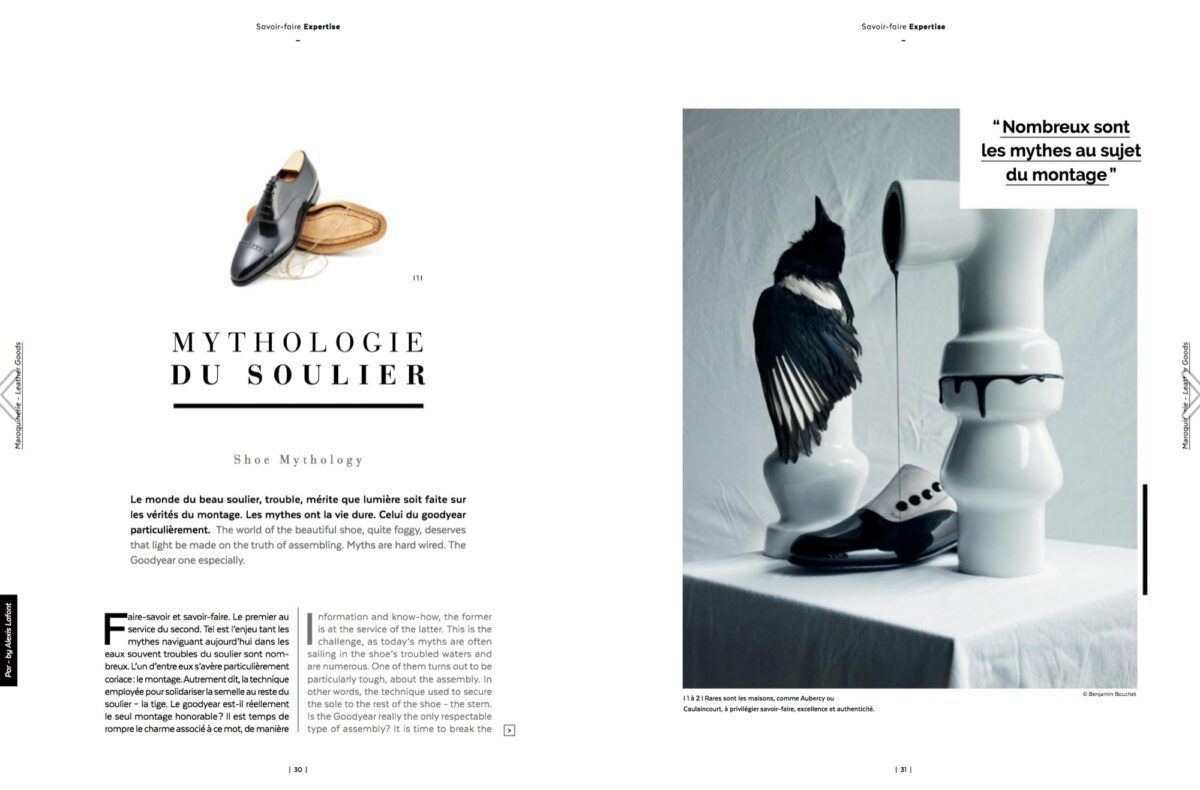My cart
No products in the cart.

This text, written by our founder Alexis Lafont for the Honoré Magazine of Spring 2018, has been returned to you here, because it seemed to us that the subject is one of the interesting themes that comes up when we talk about the beautiful book “shoe”. The theme of the article: is goodyear the only way to fit a shoe worth wearing – buying? The world of beautiful shoes, often cloudy, deserves that light be shed on the truths of editing. Myths die hard. That of the goodyear particularly. Know-how and know-how. The first at the service of the second. This is the stake, as there are so many myths sailing today in the often troubled waters of the shoe. One of them is particularly tough: editing. In other words, the technique used to secure the sole to the rest of the shoe – the upper. Is goodyear really the only honorable assembly? It is time to break the charm associated with this word, so as to reveal a more wonderful world: that of real know-how which is not a question of name but of expertise, the only guarantee of quality. Many brands are content to summon the shoe gods by placarding the name goodyear in order to hide a mediocre product, poorly assembled and sporting poor quality leather. Other houses, on the other hand, strive to design and offer a well-made product, whether it is mounted in goodyear, Bolognese or Norwegian. We often hear it: the goodyear can be resoled; it is stronger and more rigid. Most of the time, the leather of cheap shoes – fitted in goodyear – will be split before they have had time to be resole. To reduce the quality of a shoe to its fitting, or, worse, to the name of its fitting, is absurd. A blake montage from the Aubercy house is of infinitely more remarkable nobility than a goodyear marketed by houses which have only the consonance of their “brand name” in English – does goodyear have a elsewhere not invented in the UK? Coincidence…). Surprise: the same blake assembly is also resolvable! The major difference lies in the fact that the Aubercy pair will give their user time to resole them three or even four times before releasing the soul. The true value of a shoe is measured by the time it will leave its user – as long as possible – for it to become attached to the point of experiencing a real tear when the imminence of its death imposes itself as a reality. What makes the quality of the shoe is therefore not the nature of the assembly, but the care that has been taken in making the final object, as a whole. This is precisely where the craftsman and the know-how he has accumulated come into the picture; the famous experience … A handmade goodyear by shoemaker Dimitri Gomez is a work of art deserving much more consideration than the simple name given to the assembly. But it doesn’t matter whether you put one or the other on trial; The challenge is to get past the marketing smokescreen that unfortunately prevails today, in a digital world where information has become so accessible that we are paradoxically totally lost. Too much information pushes us to look for a synthesis and to go too fast. Some players take the opportunity to sell an appellation which, alas, does not always keep its promises. But beyond this split linked to the notion of quality, it is important to understand how the myth of gooyear resists when it is confronted with the onslaught of logic. Some houses, such as Caulaincourt, have developed a proposition that revolves around the notion of utility: what use will the customer have of their shoes? These houses will offer all the existing assemblies to meet the expressed use. In other words, it’s the answer that will set the tone for the edit. Does it need to be insulating to protect the biting cold of a New York sidewalk in January? Or be absolutely comfortable to accompany the user and his tuxedo overnight? The approach can be metaphorized: Would we put on waterproof shoes for a seahorse, or seven-place boots on a turtle? The use of shoes differs enormously from pair to pair, and indeed goodyear, with its pros and cons, cannot be a systematic answer. Finally, the notion of aesthetics seems important to finish cracking the dogma of goodyear or nothing. Indeed, a shoe is intended to satisfy a desire for elegance. While the goodyear construction, which features a sewn welt, that is, a sole protruding from the shoe, goes well with a pair of ankle boots, its generous proportions are more difficult to match with a tuxedo shoe. This observation makes it possible to underline how much the use of the shoe must prevail over its name, as well as the importance of the quality of the craftsman will induce in his product, and finally the issue of aesthetic balance of the final object. In truth, the goodyear myth is an absurd narrowing that hurts the feet. It is up to each house to teach its customers to savor this virile smell of leather as they savor a Parisian bakery in the early morning: their origin is the same, namely a world of pleasure and high standards, work and patience, guaranteeing the quality of future shoes.